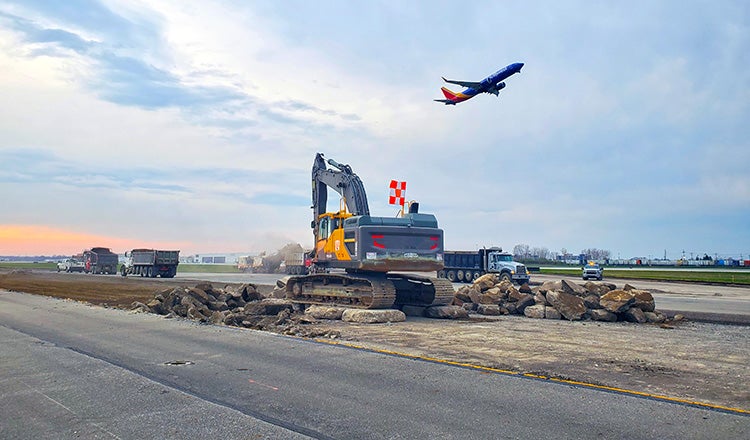John Glenn Columbus International Airport Taxiway C Relocation

John Glenn Columbus International Airport Taxiway C Relocation
In preparation for the construction of a new terminal building, John Glenn Columbus International Airport is moving a major parallel taxiway on the south airfield. The shift of Taxiway C about 200 feet south will make room for the new terminal and its apron.
Our team is providing professional engineering design and construction services to the Airport Authority for the $18 million project, including design of the relocated taxiway, lighting design, cost estimating/scheduling, site work design, development of construction documents and construction observation and material acceptance testing during construction.
Expert Airfield Knowledge
Taxiway C is a full-length parallel taxiway situated 640 feet north of Runway 10R-28L. Over two phases, the relocation project will demolish the western half of the existing taxiway and construct a new segment at a runway-taxiway separation distance of 450 feet.
Multiple members of our team helped design the existing taxiway, providing unmatched familiarity with the site and its conditions that has helped keep the project on schedule. For example, the team knew of poor subgrade soil conditions at the airport that could threaten the schedule if it became saturated with rain. To prevent this, the team used a cement treated subgrade solution that blended the existing soil with cement and mitigated the risk of soil problems.

Flexible Taxiway Design
It was clear the taxiway needed to be moved to provide room for the new terminal building, but when design work began on the relocation, the terminal plan was still in the early phases of development. That meant our team needed to be flexible on those parts of the taxiway that will connect to the new terminal apron. Coordination between the two projects was crucial, and as designs moved forward, the location of several connector taxiways that will join Taxiway C to the new terminal shifted. Our team was able to quickly react and incorporate the changes into the taxiway project to keep construction on schedule. To reduce future closures, the connectors will be built to about the halfway point between the taxiway and the new terminal. That will mean aircraft can continue to use Taxiway C while those connections are completed.
Proper construction phasing has been critical, designed to reduce the impact of construction operations on the airport and its tenants, while promoting construction efficiency and overall safety. Taxiway C is the primary parallel taxiway for the airport’s primary runway; it’s one of the heaviest used taxiways at the airport. Maintaining access during construction for both arriving and departing aircraft was important. For example, to minimize runway occupancy time and reduce taxi distances to the terminal, the project phasing keeps open at least one of the two western high speed exit taxiways open at all times. For departing aircraft, access to the 10R threshold is provided by one of the two entrance taxiways at all times.
The first phase of the project included about 2,800 feet of taxiway. Design for that segment was completed in 2022 and construction began in spring 2023. Design of the second phase — another 3,000 feet of taxiway — was completed in 2023, with construction expected to begin in 2024.











